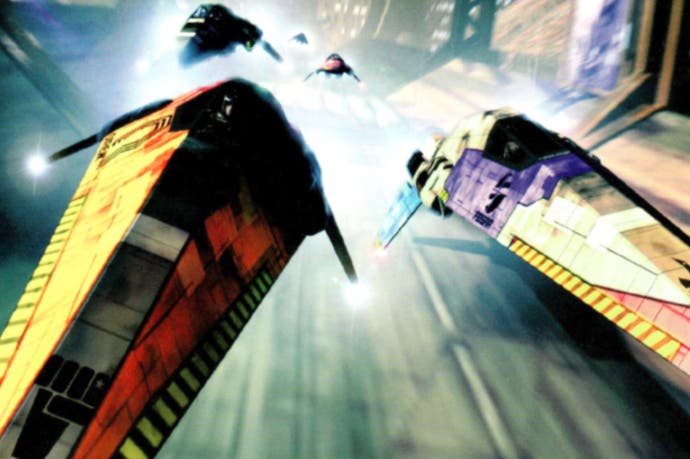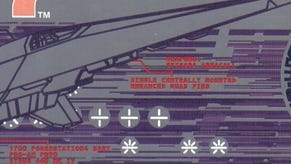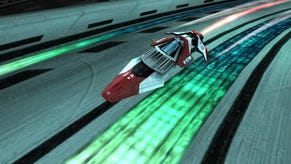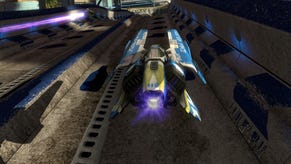PS1 at 20: The making of WipEout
Digital Foundry talks retro tech with Sony on the original PlayStation's coolest launch game.
We originally ran this piece last December, as one of a series of features to commemorate the 20th anniversary of the PS1's launch in Japan. But of course, WipEout was actually released much later as part of the European launch line-up, so we're republishing this piece today, exactly 20 years since both the game - and the console that hosted it - were finally released in Europe.
Namco's Ridge Racer demonstrated the power of the original PlayStation when it released alongside the console at the Japanese launch, 20 years ago. But for many - especially in the West - it is WipEout that is synonymous with the arrival of Sony's debut gaming hardware. Psygnosis' futuristic racer wasn't just a technological showcase for the new 3D era in console gaming, it was more than that - it was the game that made PlayStation cool for the more mainstream gamer without alienating the core.
Today, Sony's Dominic Mallinson is Vice President of Research and Development at SCEA, working on research, SDK, system software and some hardware development. Most recently, his team worked on the Project Morpheus prototype. However, 20 years ago, he was getting to grips with the original PlayStation hardware, developing WipEout first as lead programmer, then as producer.
"At the time, I was working in Psygnosis' Advanced Technology Group and we'd been developing on new CD-ROM platforms like 3DO, CD32 and FM Towns," Mallinson says. "But none of those platforms really did 3D graphics and so when we first saw the demos for PSX, we were blown away. For us the exciting thing was the combination of a formidable polygon rendering GPU with the special GTE coprocessor that accelerated 3D geometry and lighting. The SPU audio processing, the MDEC and the CD-ROM were the icing on the cake."
In terms of timelines, Psygnosis was a Sony-owned company from 1993, with the PlayStation launching in December the following year. However, access to hardware was limited. Mallinson attended technical hands-on meetings in December 1993, recalling that actual hardware arrived in the Liverpool office in spring 1994, with full production on WipEout kicking off some time in the second half of 1994 ("I could be off a little").
"The hardware was super-strong and relatively well balanced. The SPU audio processing was amazing for its time. The GTE was very powerful once we figured out how to access it at the low-level. Memory size was a challenge but nothing unusual for the day," Mallinson notes.
"I recall our initial problems were with the development tools which required some weird Sony NEWS workstation and had very little in the way of debug features. Once SN systems fixed that, next issues were with early builds on the Operating System, which didn't quite deliver what we needed."
What's remarkable is that Psygnosis adapted so quickly in an era where the nature of games development changed so radically. The transition from 2D to 3D was a seismic shift in the way that games were made, resulting in a fundamental change in the nature of the games we played. The era of 2D sprites and bitmap art was reaching its twilight years, and developers had to adapt - how did Psygnosis handle that game-changing leap from two to three dimensions?
"Well, there are two answers to this question," Mallison offers. "For the content side, we had a lot of experience with 3D in-house and our artists understood how to create models, render and animate. On the console programming side, we had to scramble a little. We had a few PC developers with experience and we brought them in-house and asked them to help train others. Fortunately, we'd already hired some recent University graduates with strong maths backgrounds to help with tools for the artists and those guys quickly made the transition from off-line to real-time 3D."
In effect, a giant reset button had been pressed on the way that games were made. The challenge wasn't just about creating a strong, robust 3D engine on prototype hardware - every element of the production process required new tools.
"I think it's fair to say that we had more issues with establishing a good content pipeline and production toolset than we did with the PlayStation itself," Dominic Mallison says, but in his area, elements of the visual presentation we take for granted today didn't come so easy to the developers of the day.
"Probably the biggest technical issue that I remember was dealing with the lack of perspective correct texturing and having to sub-divide the polygons in the track so that they looked OK up-close where the near clip plane is. The problem is that the resolution of the polygon XY positions and the necessity to have T-joints led to cracks in the track. We never did eliminate all the cracks. Also, the CD-ROM version of the development kit came relatively late in the development cycle so we had to scramble to get that working. PAL support was also really late in the development kit."
PlayStation was noted for being easy to develop for at the time, but perhaps some of that perception is down to the fact that its competition - the Sega Saturn - was so much more difficult to work with. PlayStation's streamlined design made it easier to unlock its performance, while Sony worked with SN Systems to create the development environment. It was an association that would last, with the platform holder acquiring SN in 2005.
"There were similarities to other consoles and SN Systems very quickly got their development tools working on the PlayStation, which gave us a familiar and powerful environment to work with," he says. "On the 3D programming side, we had to start from scratch. The first libraries shipped from Tokyo were too high level and so we had to do a little reverse engineering to get the maximum performance from the GTE."
With WipEout slated to launch alongside PlayStation in North American and European regions nine months after its debut in Japan, the Psygnosis teams working on the Sony hardware would have been midway through development when Namco's Ridge Racer - developed in just six months - was released. Was it any kind of yardstick by which Psygnosis could judge the quality of their work-in-progress game?
"Ridge Racer was an amazing achievement to be ready for launch in Japan," Mallinson replies. "While it influenced us a little, we always had a different feeling for what we wanted from a futuristic racer so we didn't consider it a head-to-head competition. In some ways we were more focused on a friendly rivalry with the Destruction Derby team."

With WipEout, the end result was a game that looked and played like nothing else we'd seen before - arguably more impressive from an art and technology perspective than Namco's launch masterpiece, and very much a game of its time (documented in much more depth in Wesley Yin-Poole's piece on the rise and fall of Sony Studio Liverpool - the rebadged Psygnosis). The visuals, the design ethos and the music combined to create a game that was more culturally relevant - especially to the European audience - than anything since the glut of homegrown games released in the mid-80s computing boom. But we shouldn't forget that at WipEout's heart, there was a great game in there too.
"It was a combination of design and technology, but the dynamics of the vehicles and the 'feel' for them floating on the track worked really well. I'm pretty sure that was mostly thanks to Dave Rose who did an excellent job leading the programming team," says Dominic Mallinson, revealing that some of the team's technical objectives couldn't be met. "We wanted more draw distance and we wanted more tracks and we wanted 60Hz. Draw distance and 30Hz were mostly a limit of the hardware, powerful as it was. More tracks was a limit of our production tools at the time."
Of course, WipEout evolved across the years, with strong titles released on every Sony system up until PlayStation Vita, where WipEout 2048 remains one of the best titles available on the overlooked handheld system. But Studio Liverpool is no more, and just like Ridge Racer, the series would not make it onto PlayStation 4. And as good as the back-catalogue of WipEout titles was across the generations, none of them had quite the same cultural impact as the original. During production, were the developers aware of just how important the game would be for the fledgling PlayStation hardware?
"Honestly, no. Looking back I believe that the WipEout team were committed to the game and not to the impact on PlayStation," Mallinson replies. "As is so often the case, when you have this type of belief in a game, it's infectious, and everyone in the company started to get behind it - and ultimately that carried over to the players too."










